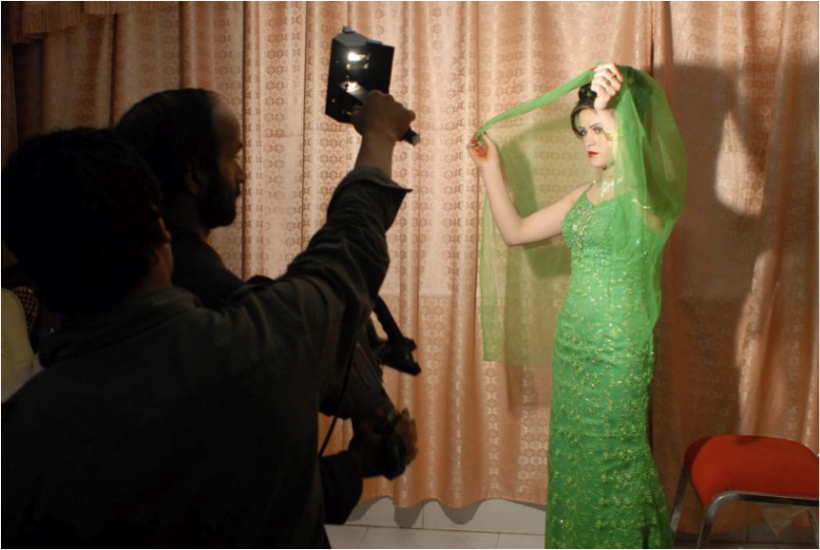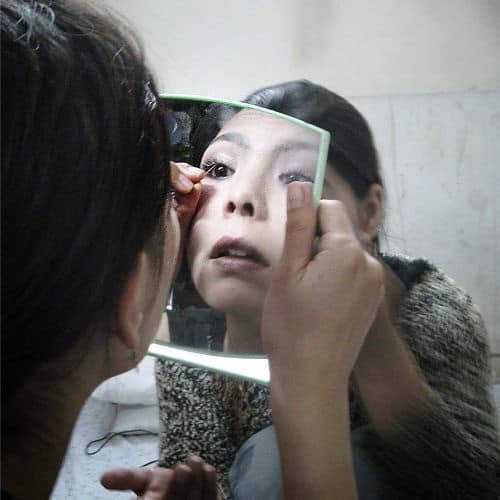My fieldwork in Afghanistan in 2007 involved a substantial amount of time spent at wedding parties. It was rare to spend a week without being invited to one. Wedding parties in Kabul usually took place in extravagant wedding halls with exotic names. Boosted by the renewal of the marriage industry, wedding halls had mushroomed on the outskirts of major Afghan cities after the fall of the Taliban regime. In Kabul, Sham-e Paris (‘Parisian Night’), with its replica of the Eiffel Tower illuminated on the forecourt, was a luxurious and exuberant complex composed of reception halls, beauty salons, cocktail dress shops, and photography studios. This overt exhibition of private wealth in the middle of overwhelming public poverty exemplified in a powerful way the contradictions inherent in the ‘transition towards democracy’.

In the beauty salons of Kabul, the walls were plastered with posters of heavily made-up Indian actresses. On special occasions such as wedding parties, Afghan women modelled themselves on these women whom they perceived as beautiful and liberated. Inside the salons, women were dying their hair, plucking their eyebrows, and brushing coloured shadow on their eyelids only to eventually hide their hard work under their chadari as soon as they returned to the street. A wedding has no price in Afghanistan. On this occasion, the groom’s family can spend up to 20.000 US dollars, a small fortune when more than half of the population is living below the poverty line. The success of a marriage is measured by the number of guests a family can afford to invite.
In a country where security is seriously lacking, a wedding is a powerful means to develop coalitions and to strengthen ties with relatives and the broader community.
The bride is never beautiful enough on her wedding day. She usually changes dresses up to three times during the party, disappearing for an hour only to reappear, like in a fashion show, under a completely new face in front of the guests. The first one she wears is traditionally white, the second green, and the last either red or blue. Make-up and hair design should match her dress colour which keeps hair dressers and beauticians busy for most of the night.
A wedding is therefore about much more than just the bride’s beauty. It is an institution through which families display wealth and tighten connections. The issue of women’s dress at weddings implicates whole families, not just the individual women concerned. Before the wedding party, women from both families traditionally spend the day together in a beauty salon. The bride’s body is entirely waxed, her feet and hands are dyed with henna, and her face receives a thick layer of make-up: all this is performed under the attentive gaze of her female relatives. Through this ritual, the bride’s body becomes the symbolic trait d’union between two families. The beautification of the bride through hair design, make-up, and dresses is the bodywork through which two families engage in a fruitful and rewarding union.
In Kabul’s luxurious halls, weddings were an opportunity to have fun and to display one’s wealth, dance skills and beauty. In contrast to the relative conformity that existed in street fashion, wedding parties were moments when one could literally ‘show off’! And of course, music was a central element of entertainment, with bands playing guests’ favorite tunes on demand. When weddings were not mixed, the women’s side of the party was usually quite distinct from the men’s side. The women’s side would have a band playing on electronic keyboards the popular tunes of the moment when the men’s side would have more traditional bands, playing classic Afghan instruments like rubab, tabla and dambura. These two playlists provide an acoustic impression of what each side of Afghan wedding fun sounded like.





Very insightful narratives drawing the social counters through the medium of cultural convergence of the Afghan in marriage.